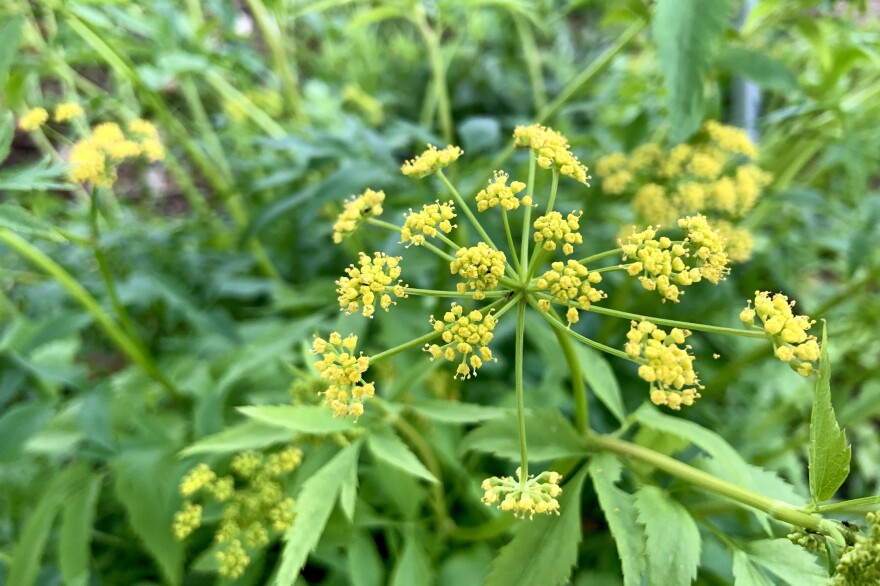You may be seeing this plant along roadsides, in abandoned meadows and fields and - hopefully - not in your own yard.
This invasive grows to about four feet tall with almost feathery foliage and yellow flowers that look a bit like Queen Anne's Lace or the native cow parsnip.
Wild parsnip or poison parsnip spreads very quickly and that's not a good thing. As it flourishes, it reduces biodiversity in fields and meadows of other plants, insects and wildlife. That is why ridding certain areas of wild parsnip is beneficial. It must also be done with a certain caution.
The plant got its "poison" moniker due to its sap, which, if it gets on your skin especially on a sunny day, can give you a rash or burn.
Guidelines from the Vermont Department of Health if you get poison parsnip sap on your skin:
- Wash your skin thoroughly with soap and water as soon as possible.
- Protect your exposed skin from sunlight for at least 48 hours.
- If you experience a skin reaction, call your health care provider.
So, to control its spread safely, you can try a couple methods. And timing here is key, as the best time to get rid of wild parsnip is now.
The plant is just flowering and if you wait another month or so, it will set seed and propagate.
If your field or meadow is full of wild parsnip, the best removal method is to rent a rotary cutter like a Brush-Hog or hire someone to mow it all down.
The wild parsnip seed can stay viable for three to four years in the soil. So this mowing-down method may take a couple of passes this year. And you might need to continue mowing it down with a rotary cutter for a number of years.
Alternately, if you just have small patches of wild parsnip, you can remove it yourself with some precautions.
Wait for a cloudy day, then don some garden boots, a long shirt, long pants and a hat. Then use a scythe or loppers to chop down the wild parsnip to ground level and leave it in the field.
This will stop the wild parsnip from trying to set flowers. If you only cut the seed head of the top, it will re-flower from the bottom branches.
Avoid getting any sap on your skin and if you do, follow the guidelines listed above from the Vermont Department of Health.
Q: I've got a full bed of annual dahlias that are dying one by one. They've been growing beautifully then overnight, they start wilting. Might this be verticillium wilt? If so, what can I safely plant in their place in a part-sun area? - Jean, via email
A: If the dahlias are planted in clay soil, that can create an almost flooded area for your flower bed after a heavy summer downpour. And this can lead to wilt and root rot. That might be what's causing the dahlias' leaves to die back.
Try pulling out the dahlias that have died back. Then, for the ones that are still looking pretty good, try to work the soil around them and loosen it. This can help with drainage.
Another alternative is to plant some other flower varieties in your garden. Now is a great time to scoop up lots of annual plants like mounding zinnias, fuchsia and coleus at greenhouses and garden centers.
Q: My daughter wants to use some garlic scapes in her wedding bouquet. The wedding is September 10th. How would you recommend I keep them until that date? - Cheryl, in Mount Tabor
A: Garlic scapes, with their lovely, long and curly tendril shapes, would make a beautiful greenery addition to bouquets!
The problem is that garlic scapes just don't last very long. They may hold up in a plastic bag in the fridge but would need to be used fairly quickly from the date of harvest.
Freezing then thawing them might work or try drying the scapes. But for sure, have a back-up greenery plan!
All Things Gardening is powered by you, the listener! Send your gardening questions and conundrums and Charlie may answer them in upcoming episodes. You can also leave a voicemail with your gardening question by calling Vermont Public at 1-800-639-2192.
Hear All Things Gardening during Weekend Edition Sunday with Vermont Public host Mary Engisch, Sunday mornings at 9:35.
Have questions, comments or tips? Send us a message or get in touch by tweeting us @vermontpublic. We've closed our comments. Read about ways to get in touch here.







